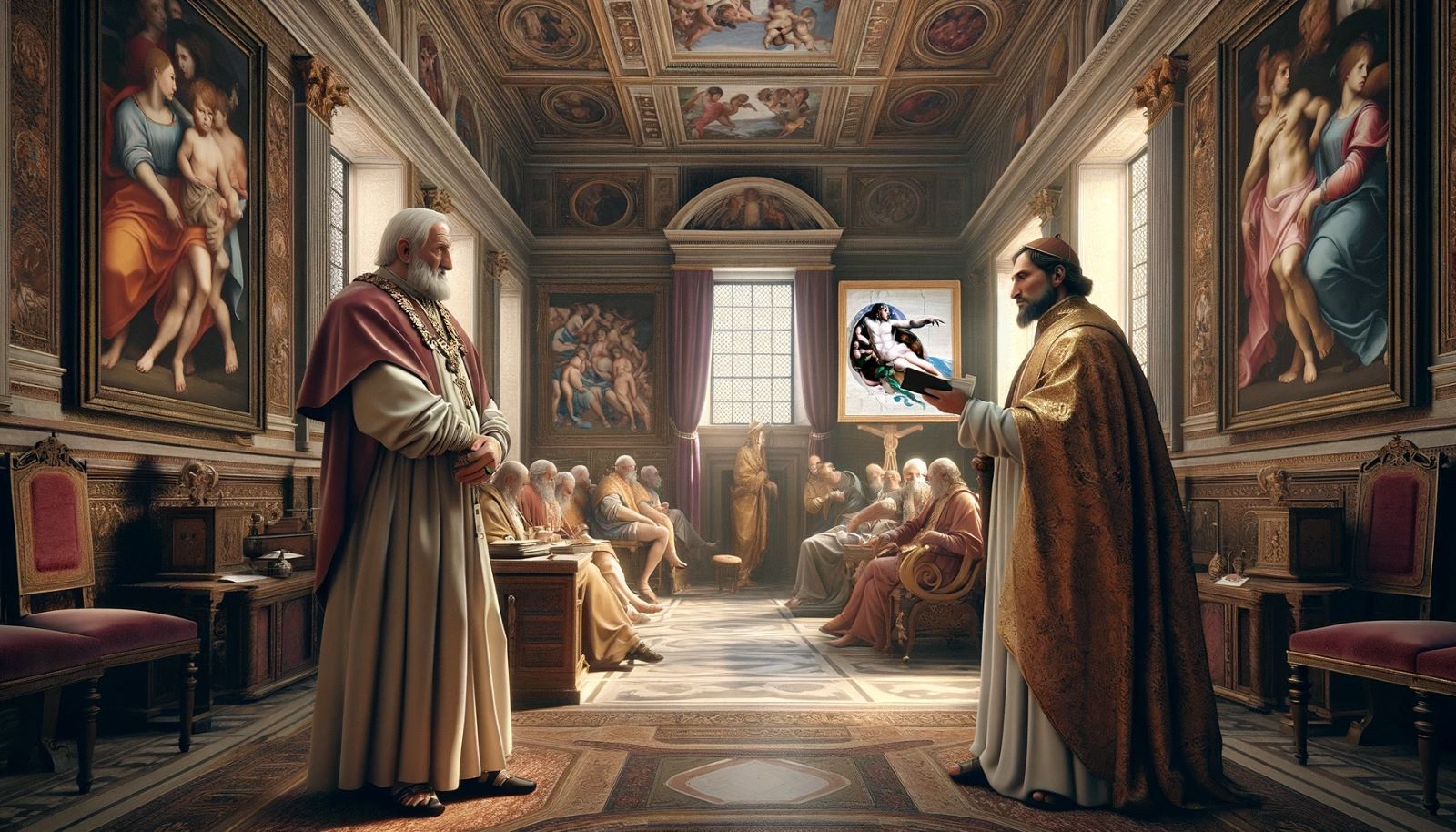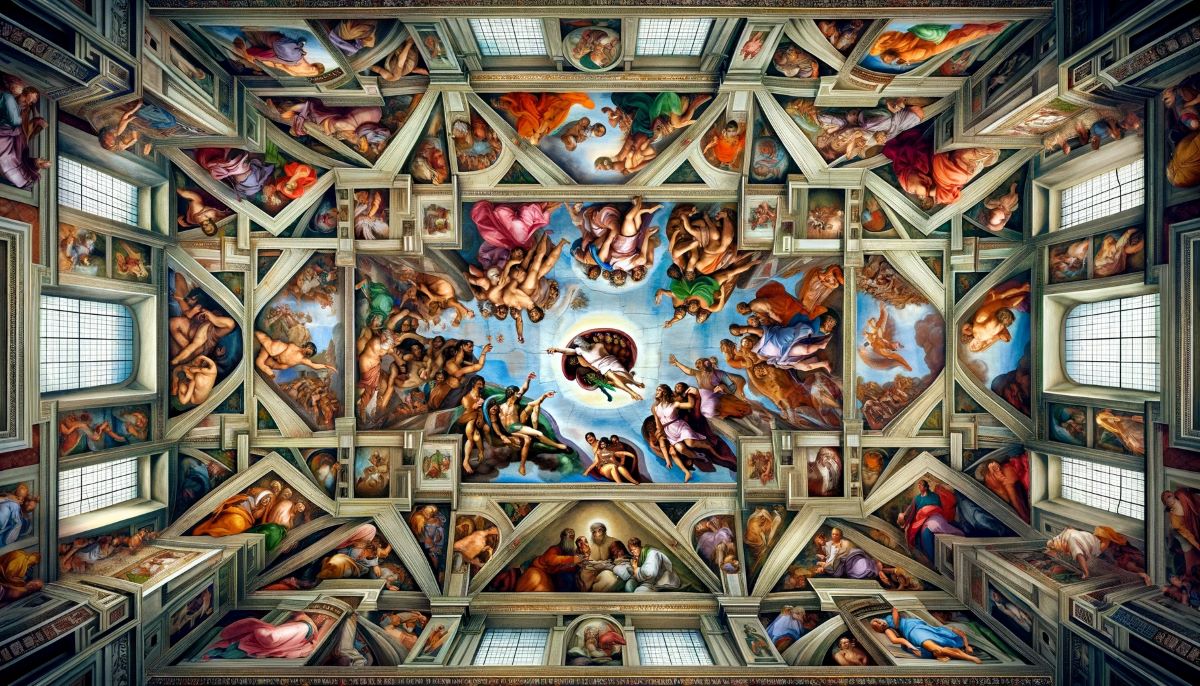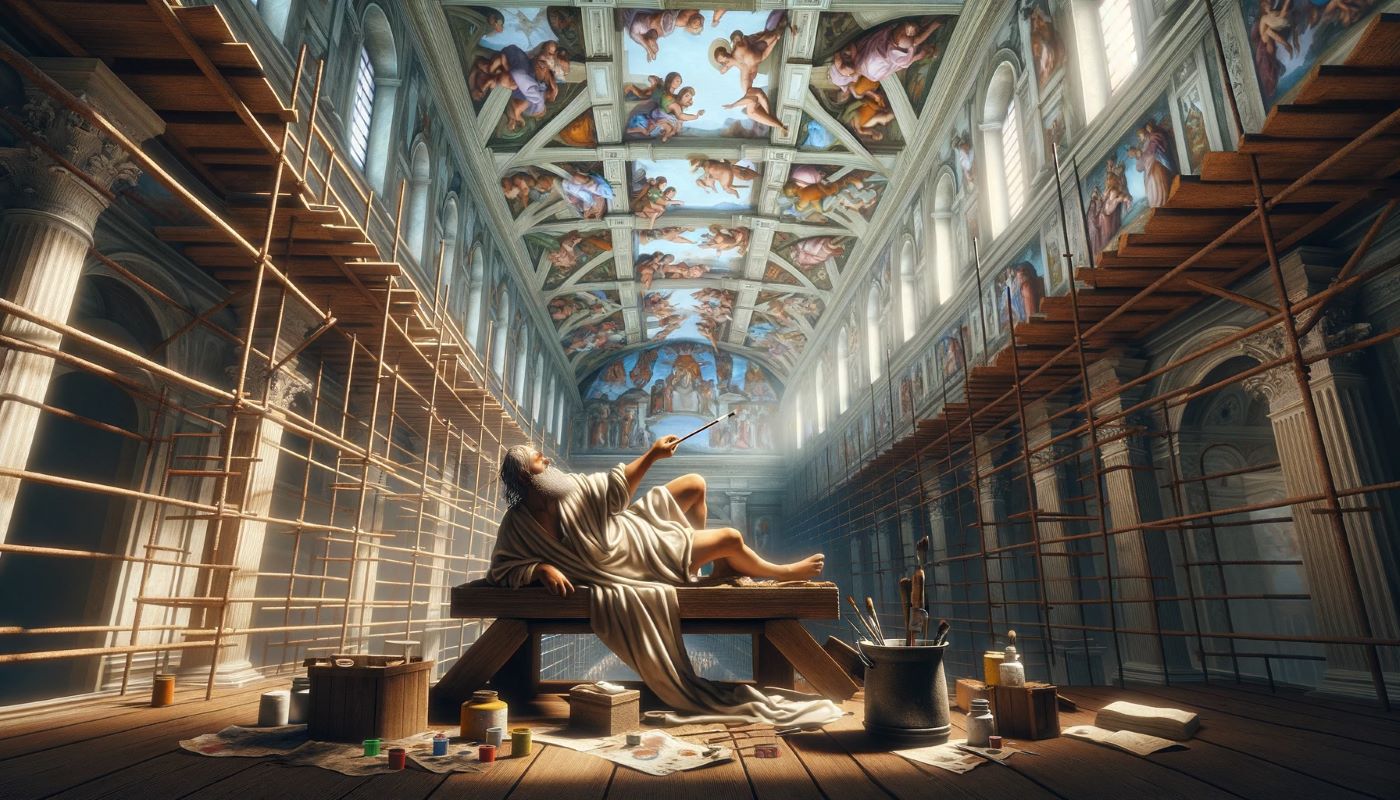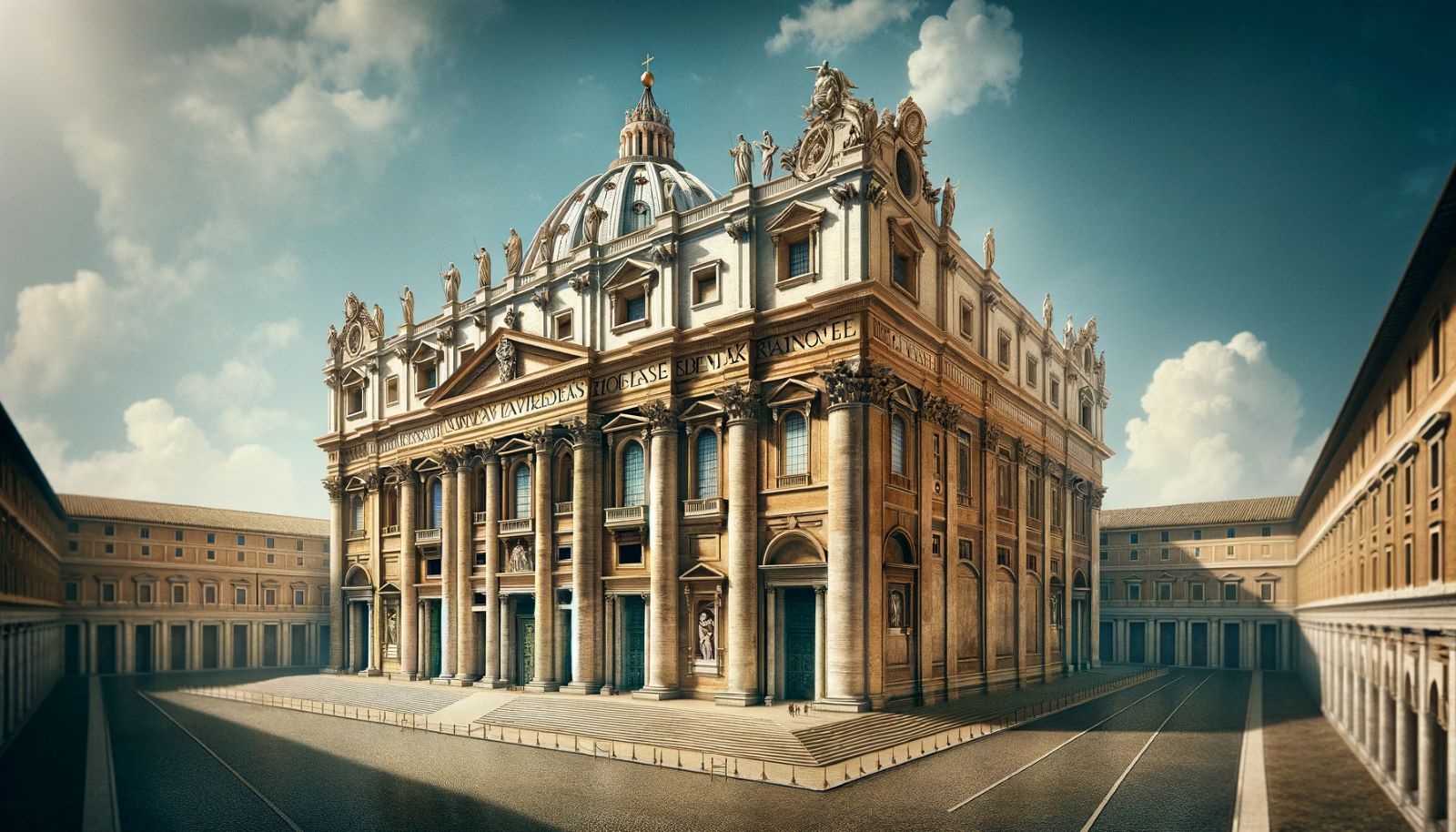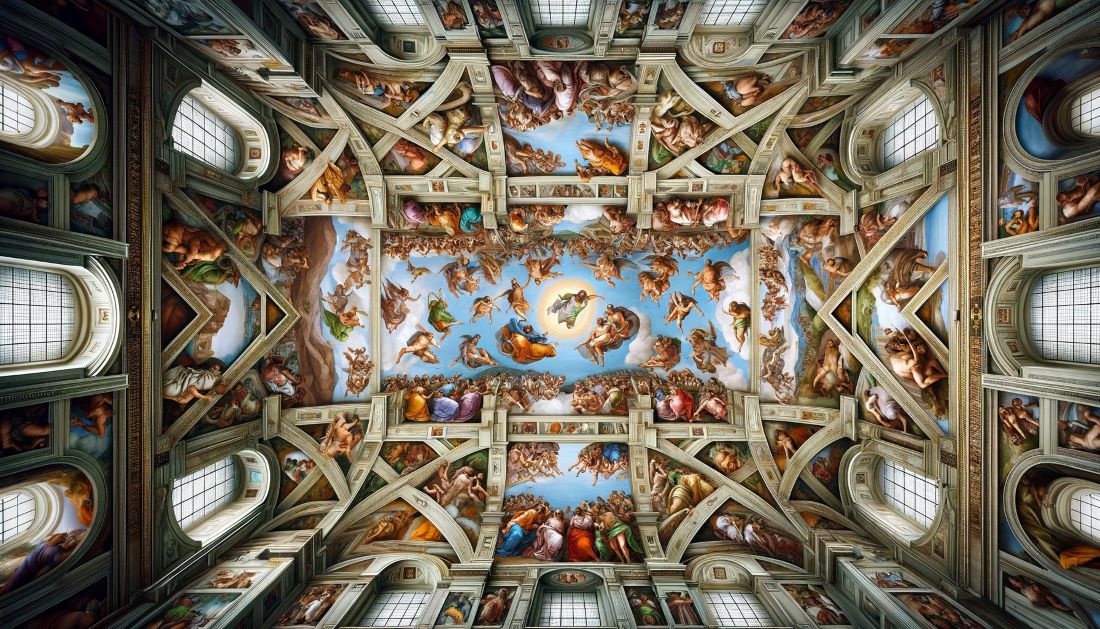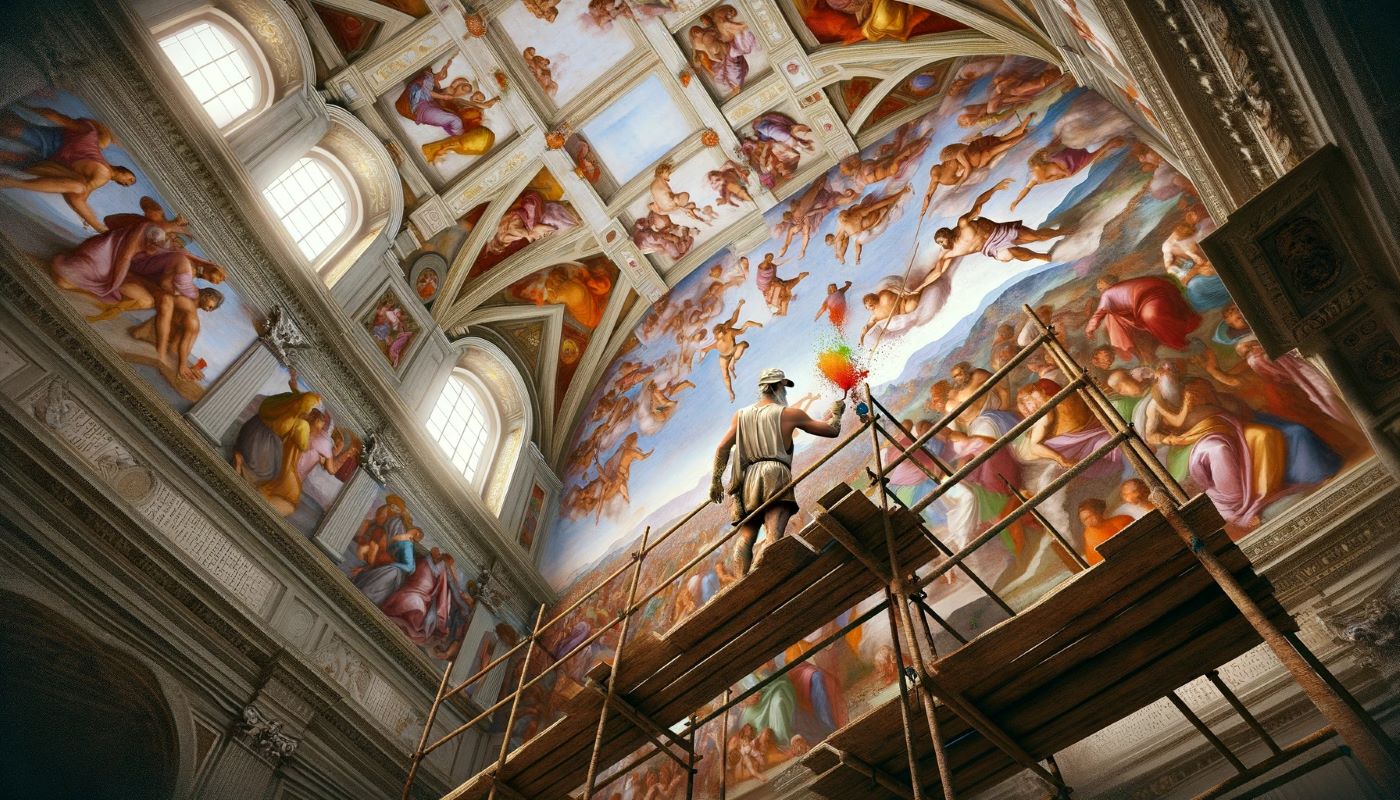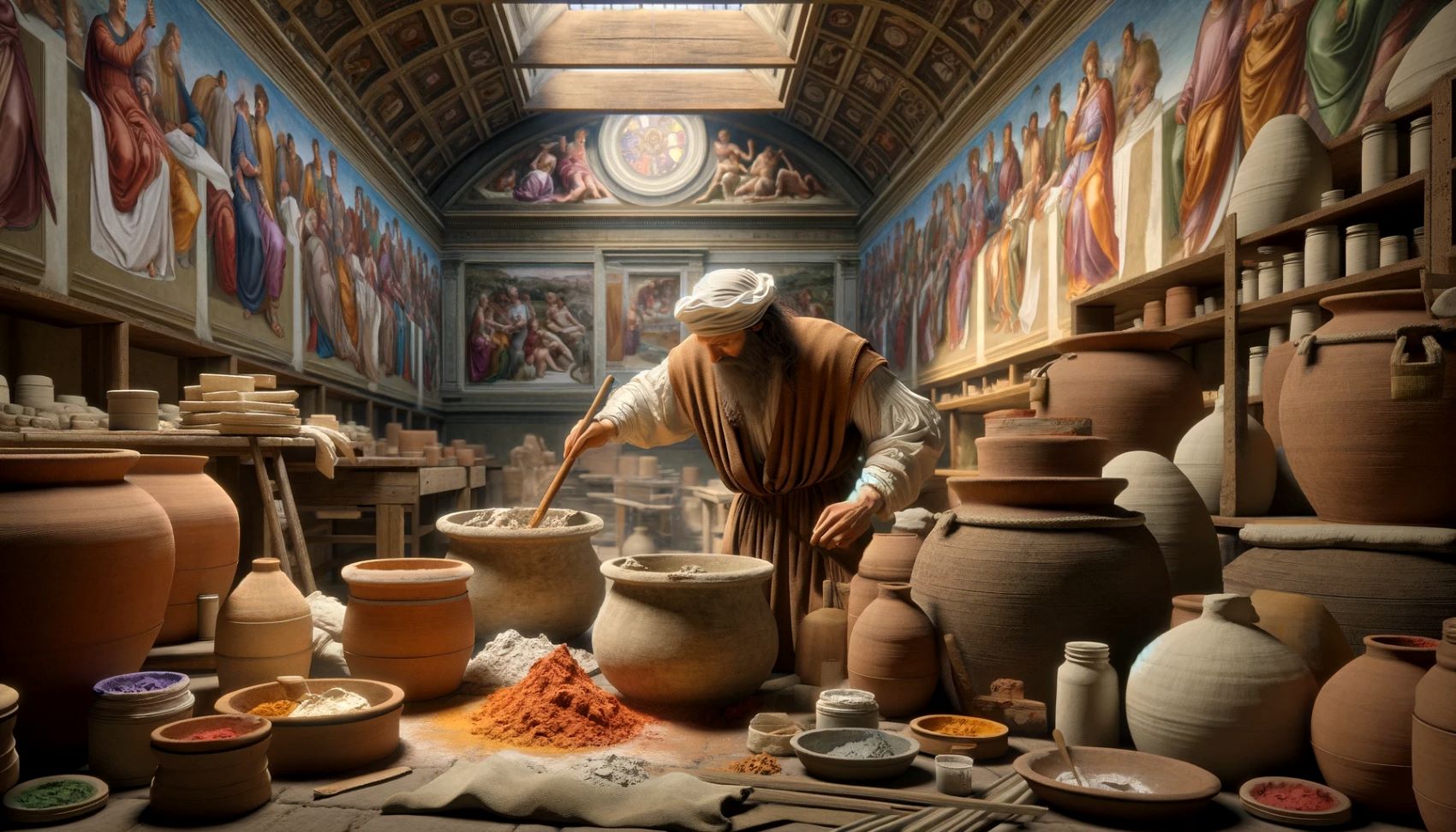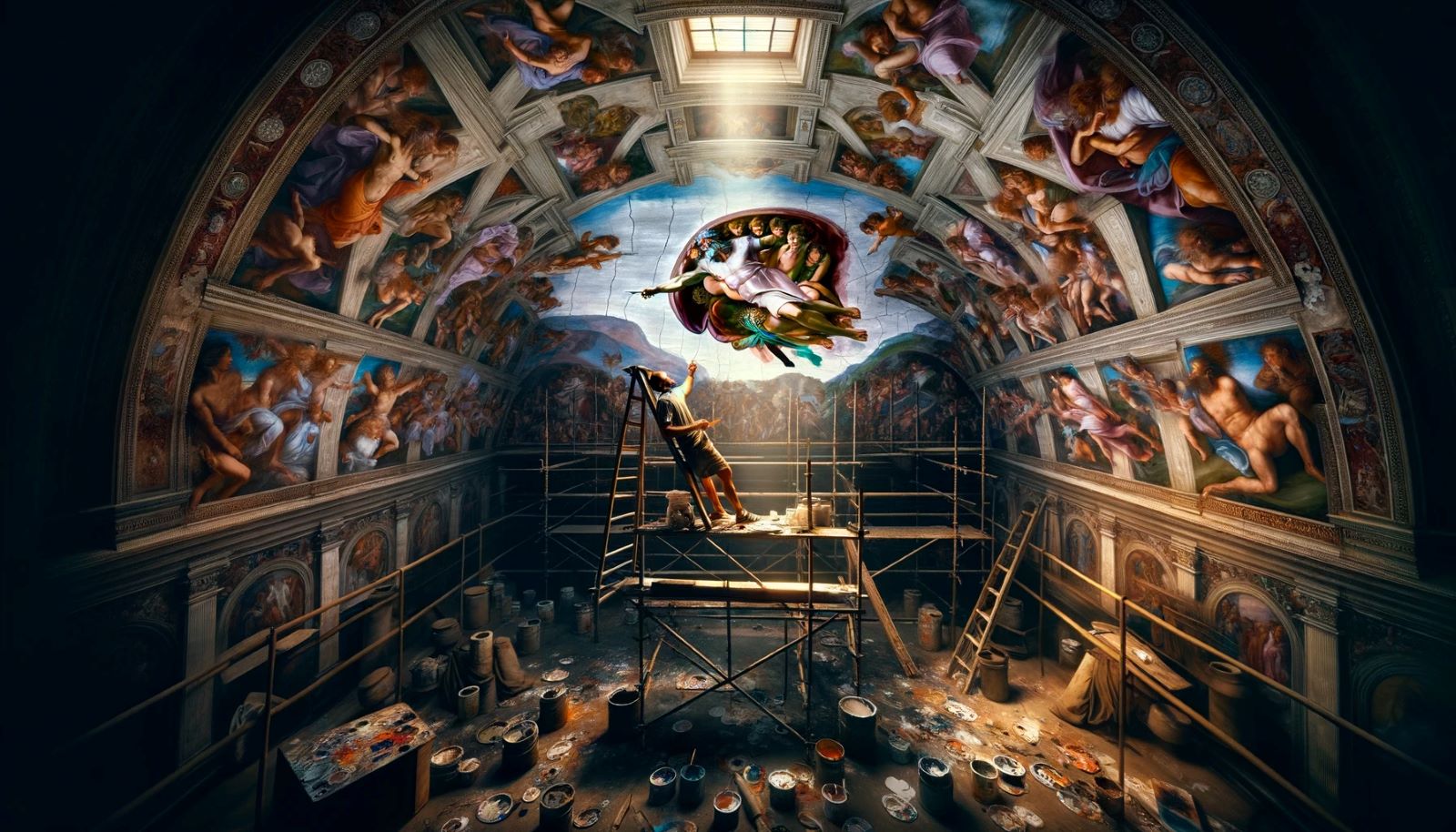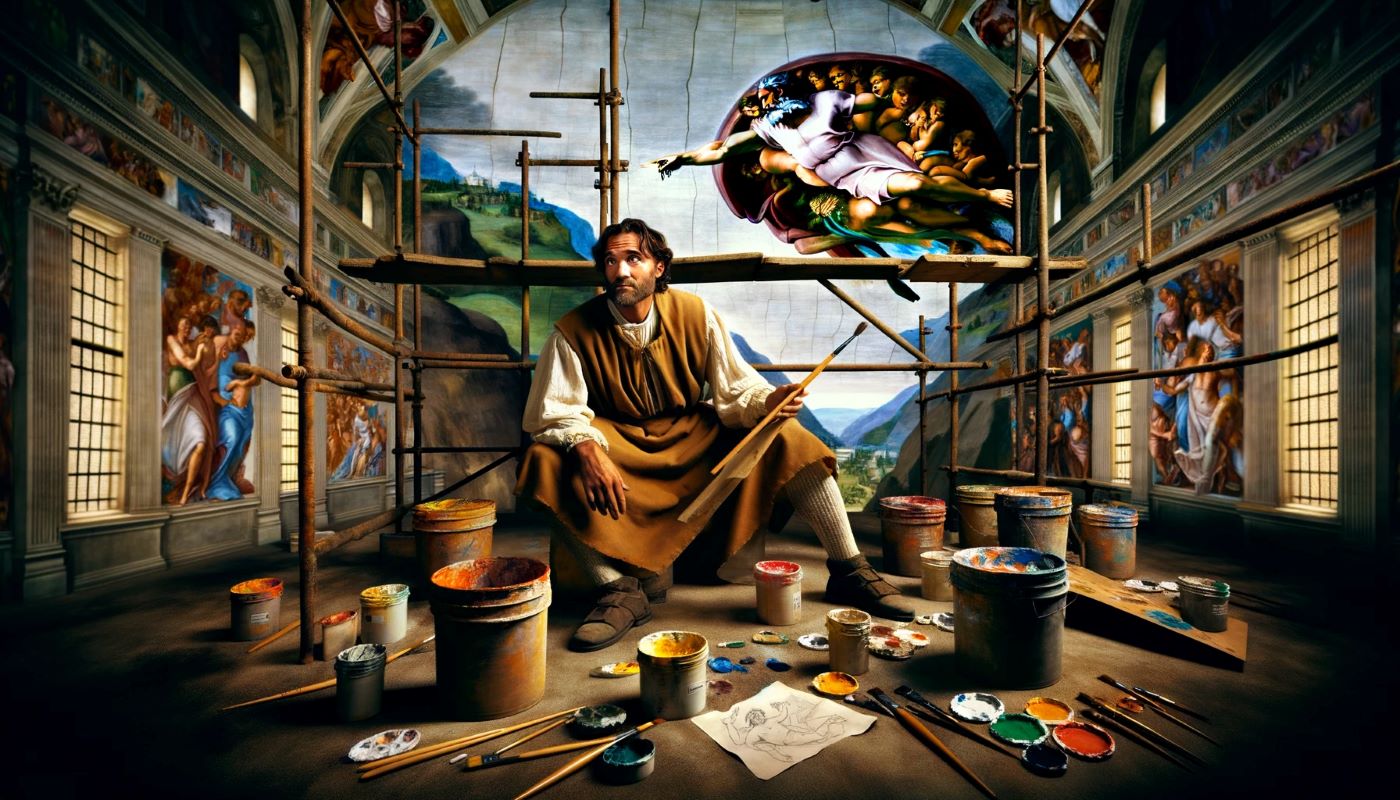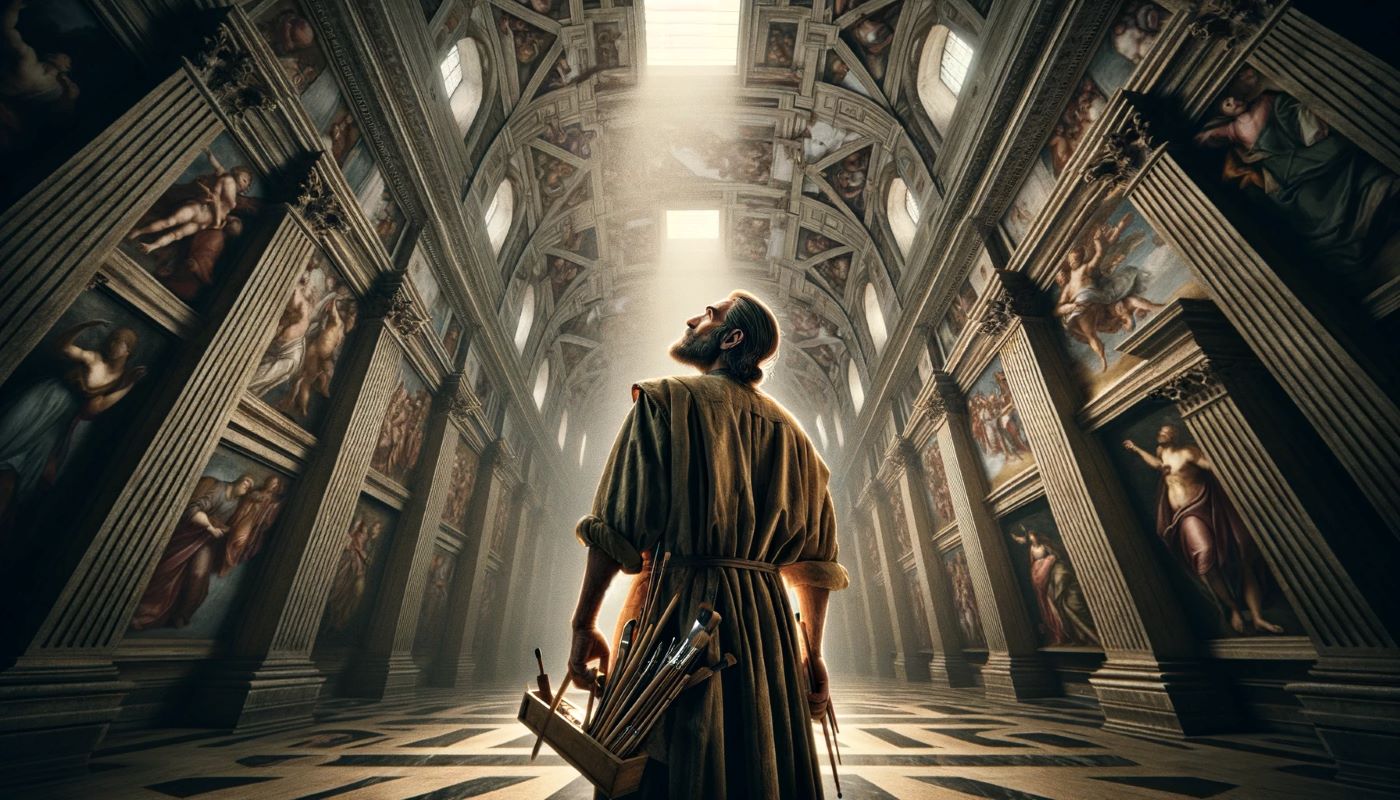Home>Arts and Culture>What Are The Paintings On The Ceiling Of The Sistine Chapel
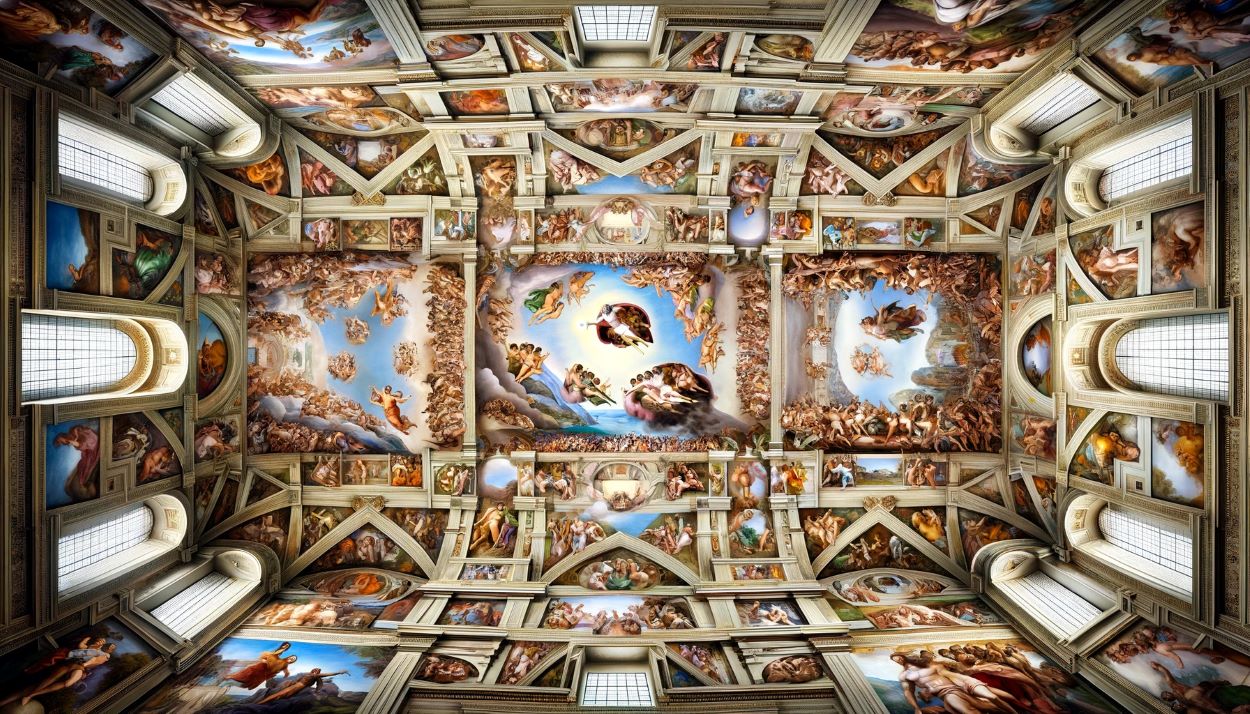

Arts and Culture
What Are The Paintings On The Ceiling Of The Sistine Chapel
Published: March 4, 2024
Ericka Andersen, an editor at Christian.net, expertly merges digital strategy with content creation, focusing on faith and societal issues. Her communication skills enhance the platform's engaging narratives, fostering meaningful dialogue on belief's impact on society.
Discover the breathtaking artistry of the Sistine Chapel ceiling paintings and their profound impact on arts and culture. Uncover the timeless beauty of Michelangelo's masterpieces.
(Many of the links in this article redirect to a specific reviewed product. Your purchase of these products through affiliate links helps to generate commission for Christian.net, at no extra cost. Learn more)
Table of Contents
Introduction
The paintings on the ceiling of the Sistine Chapel are some of the most renowned and influential works of art in the world. Created by the Italian artist Michelangelo between 1508 and 1512, these frescoes depict various scenes from the Bible and are considered masterpieces of Renaissance art. The ceiling is adorned with nine main panels, each showcasing a different biblical or historical narrative. From the iconic "Creation of Adam" to the dramatic "Last Judgment," these paintings are not only a testament to Michelangelo's unparalleled talent but also hold significant religious and cultural importance. Let's delve into the captivating stories and symbolism behind these extraordinary works of art.
The Creation of Adam
The Creation of Adam is one of the most famous and iconic scenes from the Sistine Chapel ceiling. This masterpiece portrays the biblical narrative from the Book of Genesis, where God breathes life into Adam, the first man. The painting captures the moment of divine connection and the impartation of life from the Creator to His creation. The central focus of the painting is the outstretched hands of God and Adam, almost touching but not quite, symbolizing the transference of life and the birth of humanity. The painting's composition and emotional depth have made it a timeless symbol of human potential and the relationship between humanity and the divine.
The Creation of Adam is rich in symbolism, with the surrounding figures and elements adding layers of meaning to the scene. The inclusion of angels, cherubs, and other figures in the background serves to emphasize the heavenly nature of the event. The vibrant colors and intricate details in the painting contribute to its awe-inspiring impact, drawing viewers into the divine moment being depicted. Michelangelo's masterful use of light and shadow further enhances the drama and significance of the scene, creating a sense of depth and movement that brings the narrative to life.
The Creation of Adam is not merely a religious depiction; it has also become a symbol of human potential, the pursuit of knowledge, and the quest for spiritual fulfillment. The painting's universal themes and emotional resonance have made it an enduring and influential work of art, inspiring countless interpretations and adaptations across various forms of media and culture. Its impact extends far beyond its religious origins, solidifying its place as a transcendent and timeless masterpiece.
The Last Judgment
The Last Judgment is a monumental fresco located on the altar wall of the Sistine Chapel. Painted by Michelangelo, it depicts the second coming of Christ and the final judgment of humanity. The painting is a dramatic portrayal of the biblical narrative from the Book of Revelation, where Christ is shown in the center, surrounded by saints, angels, and the souls of the resurrected. The composition is a powerful and awe-inspiring representation of divine justice and the ultimate destiny of humanity.
The Last Judgment is a complex and emotionally charged work of art, with intricate details and a dynamic composition that captures the intensity of the biblical event. The figures in the painting are depicted with raw emotion, conveying the anguish, hope, and awe of the momentous judgment. The use of light and shadow adds depth and drama to the scene, emphasizing the contrast between the saved and the damned.
The painting's portrayal of heaven, earth, and hell, along with the vivid depiction of the resurrected souls and the angels blowing trumpets, creates a sense of urgency and gravity, underscoring the eternal consequences of the judgment. The Last Judgment serves as a powerful reminder of the spiritual and moral implications of human actions and the ultimate accountability before the divine.
Michelangelo's masterful execution of The Last Judgment has solidified its status as a masterpiece of religious art and a profound meditation on the human condition. The painting's impact extends beyond its religious significance, resonating with themes of redemption, salvation, and the eternal struggle between good and evil. The Last Judgment stands as a testament to Michelangelo's artistic genius and his ability to convey profound spiritual truths through the medium of art.
The Deluge
The Deluge, also known as the Great Flood, is a significant biblical event depicted in the Sistine Chapel ceiling. Michelangelo's portrayal of the Deluge captures the harrowing narrative from the Book of Genesis, where God, in response to the corruption and wickedness of humanity, sends a catastrophic flood to cleanse the earth. The painting depicts the chaos and devastation of the flood, with powerful imagery of swirling waters, tumultuous storms, and desperate figures struggling to survive. The Deluge serves as a poignant reminder of divine judgment and the consequences of human disobedience, while also conveying themes of renewal and the enduring power of faith amidst adversity.
The Deluge panel is a striking example of Michelangelo's ability to convey intense emotion and dramatic storytelling through visual art. The tumultuous and chaotic nature of the scene is palpable, with the figures and animals depicted in various states of distress and desperation. The swirling waters and turbulent skies create a sense of overwhelming destruction, emphasizing the cataclysmic nature of the flood and the magnitude of its impact on the world.
Amidst the devastation, the Deluge also carries a message of hope and resilience. The inclusion of Noah and his family, along with the ark and the animals, represents the promise of survival and the potential for renewal after the deluge. The painting serves as a powerful testament to the enduring human spirit and the capacity for faith and perseverance in the face of overwhelming adversity.
The Deluge panel not only captures the biblical narrative of divine judgment and redemption but also serves as a timeless reflection on the universal themes of human frailty, resilience, and the enduring power of faith. Michelangelo's masterful depiction of the Deluge has cemented its place as a profound and evocative representation of one of the most enduring and impactful stories in religious and cultural history.
The Creation of Eve
The Creation of Eve, a captivating fresco on the Sistine Chapel ceiling, portrays the biblical account of the creation of the first woman, Eve, as described in the Book of Genesis. This masterful depiction by Michelangelo captures the profound moment when Eve is brought to life by the divine touch of God. The painting showcases the tender and intimate nature of Eve's creation, with God reaching out to bestow life upon her. The composition of the scene exudes a sense of reverence and significance, emphasizing the divine act of forming Eve as the companion of Adam and the mother of all humanity.
The Creation of Eve is rich in symbolism, with the surrounding figures and elements adding layers of meaning to the scene. The inclusion of Adam, who is depicted in a deep slumber as Eve is being formed from his side, underscores the interconnectedness and complementary nature of the first man and woman. The portrayal of God as the source of life and creator of humanity highlights the sacredness of the moment and the divine intention behind the creation of Eve. The painting's composition and emotional depth convey the profound significance of Eve as the embodiment of companionship, love, and the continuation of the human race.
Michelangelo's masterful use of color, light, and shadow in The Creation of Eve enhances the emotional impact of the scene, infusing it with a sense of awe and reverence. The intricate details and delicate brushwork in the painting contribute to its timeless beauty and the evocative portrayal of the divine act of creation. The Creation of Eve stands as a testament to Michelangelo's unparalleled skill in capturing the depth of human experience and the spiritual significance of biblical narratives through the medium of art.
The Creation of Eve not only serves as a religious depiction but also embodies universal themes of love, companionship, and the sacred bond between man and woman. Its enduring impact and emotional resonance have solidified its place as a timeless masterpiece, inspiring contemplation and admiration for generations to come.
The Prophet Jonah
The Prophet Jonah is a compelling fresco on the ceiling of the Sistine Chapel that depicts the biblical narrative of Jonah and the whale. Michelangelo's portrayal captures the dramatic moment when Jonah, having been cast into the sea, is swallowed by a great fish as a consequence of his disobedience to God's command. The painting conveys the tumultuous and perilous nature of Jonah's predicament, with swirling waters and tumultuous waves surrounding the prophet as he is engulfed by the massive sea creature. The scene serves as a powerful reminder of divine judgment, repentance, and the unwavering presence of God's providence even in the most dire circumstances.
The Prophet Jonah panel is a striking example of Michelangelo's ability to convey intense emotion and dramatic storytelling through visual art. The tumultuous and chaotic nature of the scene is palpable, with the figure of Jonah depicted in a state of desperation and turmoil as he is cast into the raging sea. The ferocious depiction of the sea creature adds to the sense of peril and the overwhelming forces at play in the narrative. The painting serves as a poignant representation of the consequences of disobedience and the need for repentance and submission to divine will.
Amidst the turmoil and peril, the Prophet Jonah also carries a message of hope and redemption. The inclusion of the figure of Jonah, with his arms outstretched in supplication, conveys a sense of spiritual awakening and the potential for transformation through divine intervention. The painting serves as a powerful testament to the enduring themes of human frailty, divine mercy, and the transformative power of faith and obedience.
The Prophet Jonah panel not only captures the biblical narrative of divine judgment and redemption but also serves as a timeless reflection on the universal themes of human fallibility, repentance, and the unwavering presence of divine providence. Michelangelo's masterful depiction of the Prophet Jonah has cemented its place as a profound and evocative representation of one of the most enduring and impactful stories in religious and cultural history.
The Ancestors of Christ
The Ancestors of Christ is a captivating fresco on the ceiling of the Sistine Chapel that depicts the genealogy of Jesus Christ as recorded in the Gospel of Matthew. This intricate and detailed portrayal by Michelangelo showcases the lineage of Christ, tracing it back through the generations to the patriarchs, prophets, and kings of the Old Testament. The painting serves as a visual representation of the fulfillment of Old Testament prophecies and the continuity of God's redemptive plan throughout history.
The Ancestors of Christ panel is a testament to Michelangelo's meticulous attention to detail and his ability to convey the interconnectedness of biblical narratives through visual art. The composition of the scene features a series of figures representing the ancestors of Christ, each depicted with distinctive attributes and symbols that signify their place in the genealogy. The intricate portrayal of the lineage serves as a visual testament to the fulfillment of divine promises and the unfolding of God's plan for salvation through the generations.
The inclusion of the Ancestors of Christ in the Sistine Chapel ceiling underscores the significance of Christ's lineage and the continuity of God's covenant with His people. The painting serves as a powerful reminder of the historical and spiritual heritage that culminates in the birth of Jesus Christ, emphasizing the profound connection between the Old Testament and the New Testament. The portrayal of the ancestors of Christ conveys the timeless significance of their roles in the unfolding drama of redemption, highlighting the continuity of God's faithfulness and the fulfillment of His promises through the generations.
Michelangelo's masterful depiction of the Ancestors of Christ not only serves as a visual representation of biblical genealogy but also embodies the enduring themes of divine providence, fulfillment of prophecy, and the continuity of God's redemptive plan. The painting stands as a testament to the interconnectedness of biblical narratives and the profound significance of Christ's lineage in the unfolding drama of salvation history.
The Persian Sibyl
The Persian Sibyl is a captivating fresco on the ceiling of the Sistine Chapel that portrays the Persian Sibyl, a mythical prophetess from ancient Persia. Michelangelo's depiction of the Persian Sibyl captures the enigmatic and mystical nature of the prophetic figure, presenting her as a powerful and otherworldly presence. The painting showcases the Sibyl in a contemplative pose, surrounded by symbolic elements that evoke the mysticism and wisdom associated with her legendary role as a seer and interpreter of divine knowledge.
The Persian Sibyl panel is a testament to Michelangelo's ability to infuse his art with a sense of mystery and spiritual depth. The composition of the scene features the Sibyl in a meditative stance, with her gaze directed towards the heavens, suggesting her connection to the divine realm. The intricate details and symbolic elements in the painting, such as the scroll and the architectural setting, contribute to the portrayal of the Sibyl as a conduit of ancient wisdom and prophetic insight.
The inclusion of the Persian Sibyl in the Sistine Chapel ceiling underscores the universal appeal of prophetic wisdom and the transcendent nature of divine revelation. The painting serves as a powerful reminder of the enduring fascination with the mystical and the spiritual, highlighting the timeless significance of prophetic figures across different cultures and traditions. The portrayal of the Persian Sibyl conveys a sense of reverence for the enigmatic wisdom and insight attributed to her, emphasizing the enduring allure of ancient prophecy and the pursuit of divine knowledge.
Michelangelo's masterful depiction of the Persian Sibyl not only serves as a visual representation of a mythical figure but also embodies the enduring themes of mystery, wisdom, and the timeless quest for spiritual enlightenment. The painting stands as a testament to the enduring fascination with the mystical and the prophetic, inviting contemplation and reflection on the enigmatic allure of ancient wisdom and divine insight.
The Libyan Sibyl
The Libyan Sibyl is a captivating fresco on the ceiling of the Sistine Chapel that portrays the mythical prophetess from ancient Libya. Michelangelo's depiction of the Libyan Sibyl captures the enigmatic and mystical nature of the prophetic figure, presenting her as a powerful and otherworldly presence. The painting showcases the Sibyl in a contemplative pose, surrounded by symbolic elements that evoke the mysticism and wisdom associated with her legendary role as a seer and interpreter of divine knowledge.
The Libyan Sibyl panel is a testament to Michelangelo's ability to infuse his art with a sense of mystery and spiritual depth. The composition of the scene features the Sibyl in a meditative stance, with her gaze directed towards the heavens, suggesting her connection to the divine realm. The intricate details and symbolic elements in the painting, such as the scroll and the architectural setting, contribute to the portrayal of the Sibyl as a conduit of ancient wisdom and prophetic insight.
The inclusion of the Libyan Sibyl in the Sistine Chapel ceiling underscores the universal appeal of prophetic wisdom and the transcendent nature of divine revelation. The painting serves as a powerful reminder of the enduring fascination with the mystical and the spiritual, highlighting the timeless significance of prophetic figures across different cultures and traditions. The portrayal of the Libyan Sibyl conveys a sense of reverence for the enigmatic wisdom and insight attributed to her, emphasizing the enduring allure of ancient prophecy and the pursuit of divine knowledge.
Michelangelo's masterful depiction of the Libyan Sibyl not only serves as a visual representation of a mythical figure but also embodies the enduring themes of mystery, wisdom, and the timeless quest for spiritual enlightenment. The painting stands as a testament to the enduring fascination with the mystical and the prophetic, inviting contemplation and reflection on the enigmatic allure of ancient wisdom and divine insight.
Read more: How Big Is The Sistine Chapel Ceiling
The Ignudi
The Ignudi are a series of twelve nude male figures that adorn the architectural framework of the Sistine Chapel ceiling, positioned between the main panels depicting biblical and historical narratives. Created by Michelangelo, these striking and muscular figures serve as decorative elements that add a sense of grandeur and classical beauty to the overall composition of the ceiling. Each Ignudi is positioned at the corners of the ceiling's architectural framework, creating a sense of symmetry and balance in the visual design of the space.
Michelangelo's depiction of the Ignudi showcases his mastery of human anatomy and his ability to convey a sense of physical strength and grace through his art. The figures are rendered with meticulous attention to detail, with sinewy muscles and dynamic poses that exude a sense of vitality and energy. The inclusion of the Ignudi in the architectural framework of the ceiling serves to elevate the overall aesthetic of the space, adding a sense of classical elegance and timeless beauty to the religious and historical narratives depicted in the main panels.
The Ignudi not only serve as decorative elements but also embody the classical ideal of the human form, reflecting the influence of ancient Greek and Roman art on Michelangelo's work. The figures' poses and proportions evoke the spirit of classical sculpture, emphasizing the timeless appeal of the human body as a subject of artistic expression. The inclusion of the Ignudi in the Sistine Chapel ceiling underscores Michelangelo's reverence for the classical tradition and his ability to infuse religious and historical themes with a sense of classical beauty and harmony.
Michelangelo's masterful depiction of the Ignudi not only serves as a visual representation of classical beauty but also embodies the enduring themes of human strength, grace, and the timeless appeal of the human form as a subject of artistic expression. The figures stand as a testament to Michelangelo's ability to infuse religious and historical narratives with a sense of classical elegance and the enduring allure of the human body as a symbol of artistic and aesthetic perfection.
